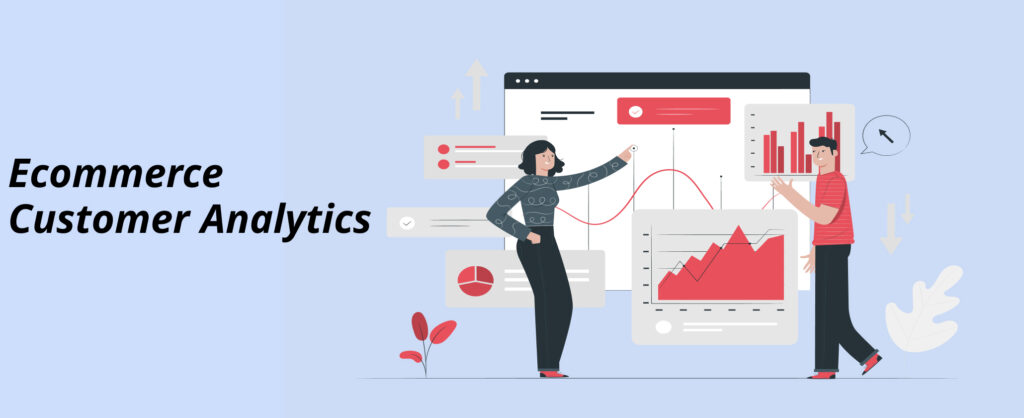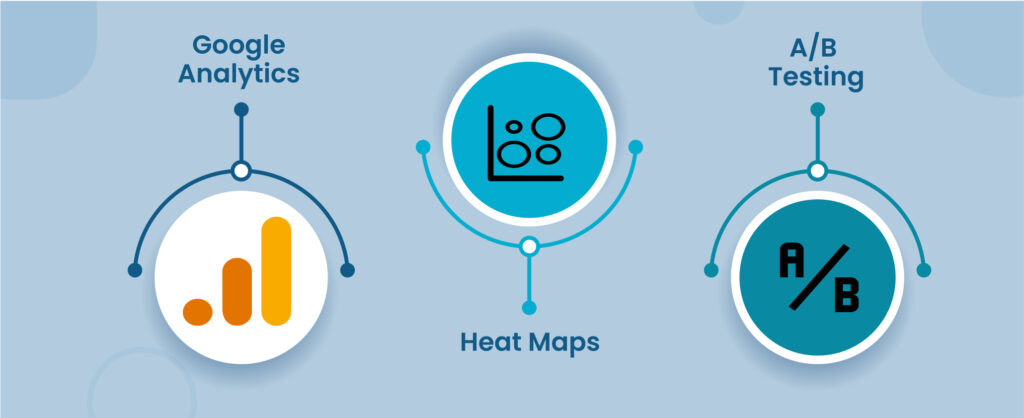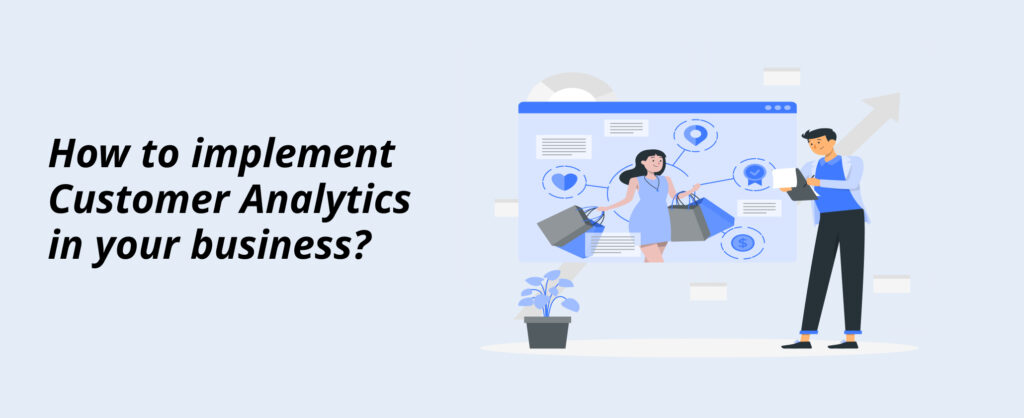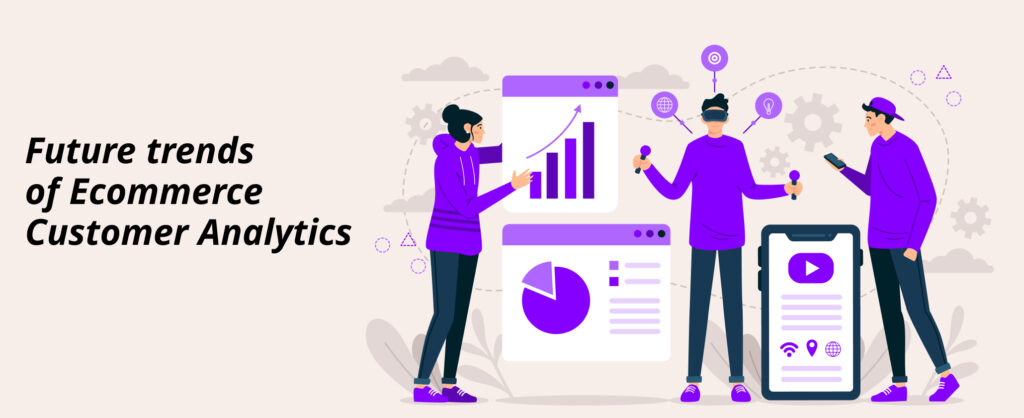Imagine trying to sell winter coats in a region where it’s summer all year round. Without proper customer analytics, you might just make such a blunder. On a more serious note, ecommerce customer analytics helps you avoid such missteps and ensures that your marketing efforts are on point.
This article by our ecommerce development company delves into the importance of customer analytics, how it works, and how it can drive smarter decision-making for your ecommerce business.
What is Ecommerce Customer Analytics?
Ecommerce customer analytics involves collecting, analyzing, and interpreting data related to customer behavior on your online store. This data includes everything from page views and click-through rates to purchase history and customer feedback. By leveraging this data, ecommerce businesses can gain valuable insights into their customers’ needs and preferences, enabling them to make informed decisions that enhance customer satisfaction and drive sales.

Why is it Important for Your Business?
Understanding customer behavior is crucial for any ecommerce development company. Following are some reasons why ecommerce customer analytics is essential:
- Personalization: By analyzing customer data, businesses can create personalized experiences for their customers, which can further lead to increased engagement and sales.
- Improved Marketing Strategies: Analytics provide insights into which marketing campaigns are effective and which are not, allowing businesses to optimize their marketing efforts.
- Enhanced Customer Retention: Understanding what keeps customers coming back can help businesses develop strategies to improve customer loyalty.
- Optimized User Experience: By analyzing how customers interact with your website, you can make data-driven decisions to enhance the user experience.
Key Metrics to Track in Customer Analytics

To effectively leverage ecommerce customer analytics, it’s important to track the right metrics. Following are some key metrics to focus on:
Customer Acquisition
Understanding where your customers are coming from and how they find your ecommerce store is vital. You can check out our latest article for more details This includes tracking the performance of various marketing channels such as social media, search engines, and email campaigns. Metrics to consider include:
- Traffic Sources: Identify which channels are driving the most traffic to your site.
- Conversion Rates: Measure the percentage of visitors who make a purchase.
Customer Retention
Retaining existing customers is often more cost-effective than acquiring new ones. Basically, analyzing customer retention metrics can help you understand how well you are keeping your customers engaged. Key metrics include:
- Repeat Purchase Rate: The percentage of customers who make a second purchase.
- Churn Rate: The rate at which customers stop doing business with you.
Customer Lifetime Value (CLV)
CLV measures the total value a customer brings to your business over their lifetime. This metric is crucial for understanding the long-term impact of your customer relationships. To calculate CLV, consider the following:
- Average Order Value: The average amount spent by customers per order.
- Purchase Frequency: How often customers make purchases.
Customer Segmentation
Segmenting your customers based on various criteria (such as demographics, behavior, and purchase history) can help you tailor your marketing efforts and improve customer satisfaction. Important segmentation metrics include:
- Demographic Data: Information such as age, gender, and location.
- Behavioral Data: Insights into how customers interact with your site.
Tools and Techniques for Ecommerce Customer Analytics

Several tools and techniques can also help you gather and analyze customer data effectively. Following are some popular options:
— Google Analytics
Google Analytics is a powerful tool for tracking website traffic and user behavior. It provides detailed reports on metrics such as page views, bounce rates, and conversion rates. However, with Google Analytics, you can gain insights into how customers find and interact with your ecommerce store.
— Heatmaps
Heatmaps visually represent where users click, scroll, and hover on your website. However, tools like Hotjar and Crazy Egg can help you understand which areas of your site are getting the most attention and which are being ignored.
— A/B Testing
A/B testing involves comparing two versions of a webpage or marketing campaign to see which performs better. This technique can further help you optimize your website and marketing efforts based on data-driven insights.
— Customer Feedback Tools
Gathering direct feedback from customers is invaluable. Tools like SurveyMonkey & Qualtrics basically allow you to create surveys and collect feedback that can provide insights into customer satisfaction and areas for improvement.
How to Implement it in Your Business?

Implementing ecommerce customer analytics involves several steps:
1. Define Your Goals: Identify what you want to achieve with your analytics efforts, such as increasing sales, improving customer retention, or optimizing marketing campaigns.
2. Collect Data: Use the tools mentioned above to gather data on customer behavior and preferences.
3. Analyze Data: Interpret the data to identify trends and insights that can inform your business decisions.
4. Take Action: Use the insights gained from your analysis to make informed decisions that enhance your ecommerce business.
5. Monitor and Adjust: Continuously monitor your analytics efforts and make adjustments as needed to ensure ongoing success.
Challenges and Best Practices
While ecommerce customer analytics can provide valuable insights, it also comes with challenges. Following are some common challenges and best practices to address them:
Data Overload: With so much data available, it can be overwhelming to determine what’s important. Focus on the key metrics that align with your business goals and use them to guide your analysis.
Privacy Concerns: Collecting customer data comes with privacy concerns. Ensure that you further comply with data protection regulations & clearly communicate your data collection practices to customers.
Integrating Data Sources: Integrating data from multiple sources can be challenging. Use tools that basically allow you to consolidate data from various platforms for a better view of customer analytics.
Continuous Improvement: Analytics is an ongoing process. Hence, regularly review your data, update your strategies, and stay informed about new tools and techniques to ensure continuous improvement.
Future Trends in the Field of Customer Analytics

As technology continues to evolve, so does the field of ecommerce customer analytics. Following are some future trends to watch for:
- Artificial Intelligence (AI): AI can further help automate data analysis and provide deeper insights into customer behavior.
- Predictive Analytics: This involves using historical data to predict future customer behavior, basically allowing businesses to make proactive decisions.
- Personalization at Scale: As analytics tools become more advanced, businesses will further be able to offer personalized experiences to a larger customer base.
Frequently Asked Questions
Ecommerce customer analytics involves collecting and analyzing data related to customer behavior on your online store to gain insights and make informed decisions.
Customer segmentation helps tailor marketing efforts and improve customer satisfaction by targeting specific groups based on demographics, behavior, and purchase history.
A/B testing allows you to compare different versions of a webpage or campaign to determine which performs better, helping you optimize your site and marketing efforts.
Popular tools include Google Analytics, heatmaps (Hotjar, Crazy Egg), A/B testing tools, and customer feedback tools (SurveyMonkey, Qualtrics).
Predictive analytics uses historical data to forecast future customer behavior, enabling you to make proactive decisions and stay ahead of trends.
Our Final Words
In conclusion, ecommerce customer analytics is a powerful tool for understanding your customers and making data-driven decisions that enhance your ecommerce business. By tracking key metrics, using the right tools, and implementing best practices, you can further gain valuable insights that drive growth and success.
Remember, the key to effective analytics is continuous improvement and staying informed about the latest trends and technologies in the field. However, you can simply also Connect with experts for it.
Stay Tuned for Latest Updates
Fill out the form to subscribe to our newsletter





